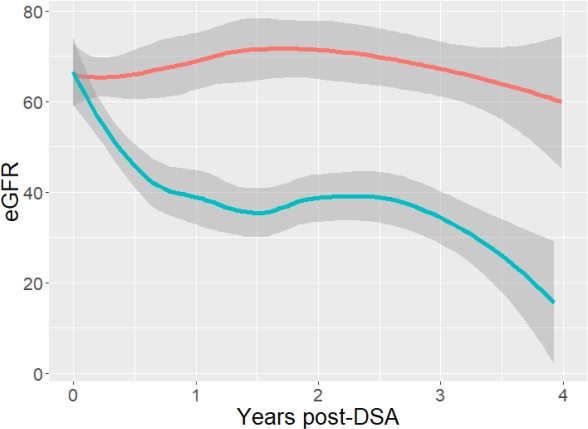Two Trajectories of Post-DSA eGFR after Kidney Transplant
1Terasaki Research Institute, Los Angeles, CA
2East Carolina University, Greenville, NC
3Vidant Medical Center, Greenville, NC
4Eastern Nephrology Associates, Greenville, NC.
Meeting: 2018 American Transplant Congress
Abstract number: 513
Keywords: Glomerular filtration rate (GFR), Graft failure, IgG
Session Information
Session Name: Concurrent Session: Kidney Complications: Antibody & Late Outcomes
Session Type: Concurrent Session
Date: Tuesday, June 5, 2018
Session Time: 4:30pm-6:00pm
 Presentation Time: 5:30pm-5:42pm
Presentation Time: 5:30pm-5:42pm
Location: Room 4B
A clearer understanding of the patterns of glomerular filtration rate (GFR) decline following donor-specific antibody (DSA) development and the factors that might be associated with a faster decline in function are needed. Herein, we study post-DSA GFR decline in 52 DSA-positive renal transplant patients.
Methods: We performed a retrospective analysis of de novo DSA positive transplant patients transplanted at a single transplant center between 11/1999 and 4/2011. All patients underwent frequent HLA IgG serial antibody monitoring by LABScreen® single antigen beads with IgG3 testing after DSA was found positive. Only patients with an eGFR>50 at the time of DSA were included in the analysis. Latent class mixed models were fit to all available eGFR measurements post-DSA. The number of latent classes was identified based on BIC. After patients were classified according to posterior probabilities, variables associated with class membership were identified.
Results: A total of 52 patients were included in the analysis. Two latent classes were identified (Figure): patients with stable eGFR post-DSA (n=28) and patients with rapidly declining eGFR post-DSA (n=24). Patients in the declining trajectory (compared to the stable eGFR cohort) were more likely to have had a living donor (33% vs 7%), have experienced an acute rejection episode (71% vs 25%), have IgG3+ DSA (65% vs 9%), died during follow-up (38% vs 14%), or experience graft failure (58% vs 25%). There were not substantial differences between the classes in age at transplant, race, gender, or delayed graft function. 
Conclusion: Our findings support the idea that patients may take clear clinical courses after the onset of DSA. Those who develop or have a history of acute rejection and those who have IgG3 positive DSA are more likely to have a fast decline in eGFR and proceed to allograft failure and possibly death.
CITATION INFORMATION: Beaumont J., Briley K., Maldonado A., Haisch C., Bolin P., Kendrick S., Jones H., McLawhorn K., Leeser D., Rebellato L., Everly M. Two Trajectories of Post-DSA eGFR after Kidney Transplant Am J Transplant. 2017;17 (suppl 3).
To cite this abstract in AMA style:
Beaumont J, Briley K, Maldonado A, Haisch C, Bolin P, Kendrick S, Jones H, McLawhorn K, Leeser D, Rebellato L, Everly M. Two Trajectories of Post-DSA eGFR after Kidney Transplant [abstract]. https://atcmeetingabstracts.com/abstract/two-trajectories-of-post-dsa-egfr-after-kidney-transplant/. Accessed December 25, 2025.« Back to 2018 American Transplant Congress
